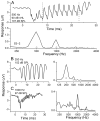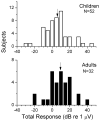Round window electrocochleography just before cochlear implantation: relationship to word recognition outcomes in adults
- PMID: 24317211
- PMCID: PMC4447311
- DOI: 10.1097/MAO.0000000000000219
Round window electrocochleography just before cochlear implantation: relationship to word recognition outcomes in adults
Erratum in
- Otol Neurotol. 2014 Aug;35(7):1265. Campbell, Adam T [corrected to Campbell, Adam P]; Dillon, Margaret P [corrected to Dillon, Margaret T]
Abstract
Hypotheses: Electrocochleography (ECoG) to acoustic stimuli can differentiate relative degrees of cochlear responsiveness across the population of cochlear implant recipients. The magnitude of the ongoing portion of the ECoG, which includes both hair cell and neural contributions, will correlate with speech outcomes as measured by results on CNC word score tests.
Background: Postoperative speech outcomes with cochlear implants vary from almost no benefit to near normal comprehension. A factor expected to have a high predictive value is the degree of neural survival. However, speech performance with the implant does not correlate with the number and distribution of surviving ganglion cells when measured postmortem. We will investigate whether ECoG can provide an estimate of cochlear function that helps predict postoperative speech outcomes.
Methods: An electrode was placed at the round window of the ear about to be implanted during implant surgery. Tone bursts were delivered through an insert earphone. Subjects included children (n = 52, 1-18 yr) and postlingually hearing impaired adults (n = 32). Word scores at 6 months were available from 21 adult subjects.
Results: Significant responses to sound were recorded from almost all subjects (80/84 or 95%). The ECoG magnitudes spanned more than 50 dB in both children and adults. The distributions of ECoG magnitudes and frequencies were similar between children and adults. The correlation between the ECoG magnitude and word score accounted for 47% of the variance.
Conclusion: ECoGs with high signal-to-noise ratios can be recorded from almost all implant candidates, including both adult and pediatric populations. In postlingual adults, the ECoG magnitude is more predictive of implant outcomes than other nonsurgical variables such as duration of deafness or degree of residual hearing.
Figures






References
-
- Firszt JB, Holden LK, Skinner MW, et al. Recognition of speech presented at soft to loud levels by adult cochlear implant recipients of three cochlear implant systems. Ear Hear. 2004;25:375–87. - PubMed
-
- Cohen NL, Waltzman SB, Fisher SG. Prospective randomized clinical trial of advanced cochlear implants: preliminary results of a Department of Veterans Affairs Cooperative Study. Ann Otol Rhinol Laryngol. 1991;100:823–9. - PubMed
-
- Gantz BJ, Woodworth GG, Knutson JF, et al. Multivariate predictors of audiological success with multichannel cochlear implants. Ann Otol Rhinol Laryngol. 1993;102:909–16. - PubMed
-
- Nadol JB., Jr Patterns of neural degeneration in the human cochlea and auditory nerve: implications for cochlear implantation. Otolaryngol Head Neck Surg. 1997;117:220–8. - PubMed
Publication types
MeSH terms
Grants and funding
LinkOut - more resources
Full Text Sources
Other Literature Sources
Medical
Miscellaneous

